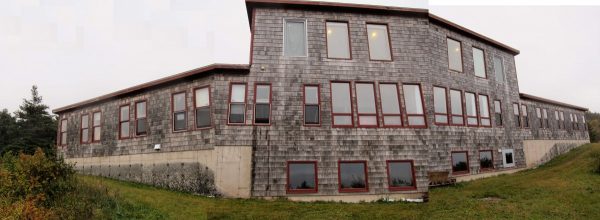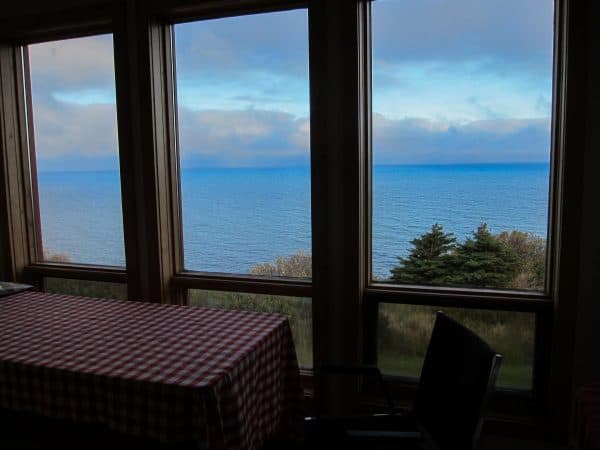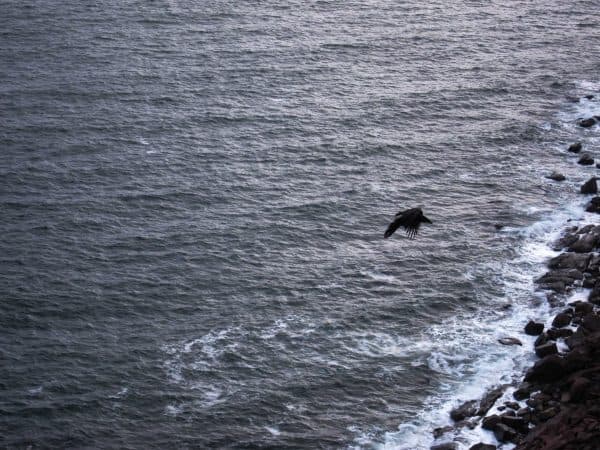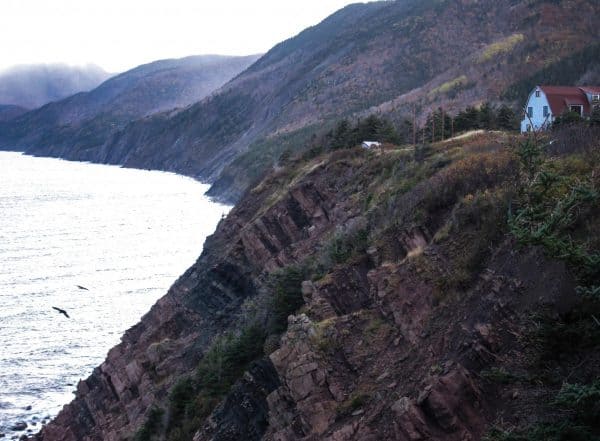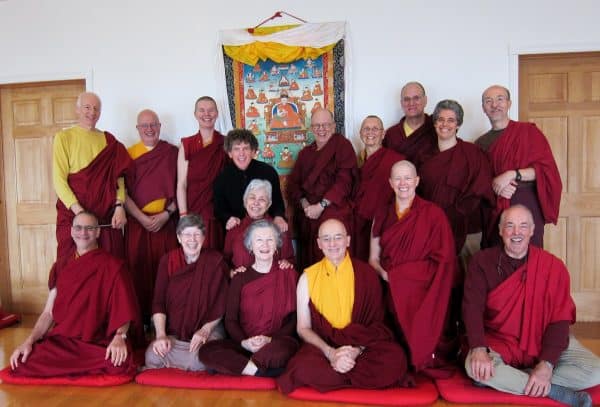Sopa Chöling
Family email sent from Halifax, Nova Scotia, November 2016
Hi everyone: I'm writing this from the bar at the Alt Hotel in Halifax. Tomorrow I'll head back to Minnesota. The next day is election day; good luck to our side. I'll drive down to Madison on the 13th of December.
I flew into Halifax about two weeks ago and had a nice dinner with Larry Mermelstein and Tingzin Otro. Tingdzin is a westerner, but was a monk for many years and kept the Tibetan name he was given on ordination. Larry is director of the Nalanda Translation Committee, Trungpa Rinpoche's translation group. Tingdzin has helped with some things over the last 20 years so, I wanted to treat him to dinner.
The next day I was picked up by a shuttle at the Alt Hotel. The shuttle was not much more than some guy's rusty brown van with a magnetic sign saying "NS Shuttle" slapped on it. We drove north for a few hours to a small town called Baddeck. About halfway there we stopped at a Tim Horton's for gas and a break. The shuttle driver had a thick Newfoundland accent. When the van came to stop he said, "Wee-a be hyah abut fie minna. Fie minna. An a-settul up hyah wi can." ("We'll be here about five minutes, and settle up here, we can.") I got out of the van, reached into my wallet, and pulled out 70 Canadian dollars. He turned to me and I handed the money to him. He smiled and said, "Yr tiched yu illbu. Ya tich ya illbu wen ya hanno moni ti mee-ah!" I said, "What?" He pointed to his elbow. Then he held out his arm and touched his elbow. I got it then--he had said, "You touched your elbow when you handed money to me." I picked up that habit from working for the Naropa Study Abroad groups in Asia. It's regarded as a gesture of respect to touch your left hand to your right elbow when you hand money to someone. He recognized that. I said, "So, you worked in Asia?" and he said, "All over: Kuwait, China, Philippines." We had a nice conversation on our way north after that, but I couldn't understand much.
He dropped me off at the Tim Horton's in Baddeck. I got a grilled cheese and wondered how I'd recognize whoever had been dispatched from Gampo Abbey to get me. I needn't have worried; I saw a car pull in and a 50-ish lady get out, scanning the parking lot. That was Nancy Huszagh, the Drüppon of the retreat. ("Drüppon" is a title given to the director of a retreat or retreat center.)
We drove to Gampo Abbey. Gampo Abbey is located at what seems to be land's end for North America; I think the only settlement further out in Nova Scotia is the town of Meat Cove. Gampo Abbey itself is a house and barn converted into a monastic living environment. It was established under the direction of Trungpa Rinpoche and Pema Chödron. Pema is a famous western teacher known for a bunch of best-selling books with very sad titles ("The Places that Scare You", "When Things Fall Apart"). I bought Miriam one of Pema's books when she seemed to be in some pain at college and I'm guessing that sort of purchase amounts to a pretty big percentage of Pema's buyers: people who want to do something for their hurting friend/parent/child. (Buy a Pema book, send book, then book probably shelved, unread.)
Gampo Abbey housed about 8 lifetime monastics until last year when they mutinied and set up new monastic housing near Halifax. These days Gampo Abbey is nearly empty. A little spooky. I'd go over there in the evenings to get email or print handouts. In a few months a group of new monastics practicing "Shambhala monasticism" will move in. I'm not sure what that is, exactly.
Just south of the abbey is the three-year retreat center called Sopa Chöling. Sopa Chöling is a stand-alone center devoted to three-year retreats. That is, once a person signs up for the Sopa Chöling retreat they don robes, take monastic vows, and don't walk back through the gate leading out of Sopa Chöling until the retreat is finished. This group will be in until next August. The building has a kitchen and shrine room in the central portion, and two long wings on either side housing very small rooms for the monks (north side) and nuns (south side). The monks and nuns sleep sitting up, for the most part, in meditation boxes. Most of their practice is done in their rooms. There are two rooms in the basement called "yoga rooms," and that's where I'd teach.
Both Sopa Chöling and Gampo Abbey are perched on cliffs overlooking the Gulf of St. Lawrence. The weather is intense and the landscape spectacular.
Here it is on Google Maps: https://goo.gl/FHFAYc
The retreat center of Sopa Chöling is the pink building on the cliff, south of Gampo Abbey on the map where the road curves around. .
During the drive from Baddeck Nancy and I talked about lots of things, but mostly about the fact that this group in Sopa Chöling will be the last to do the three-year retreat. It's a complicated situation and too much to go into here. My job was to teach four or five people who had come up to Sopa Chöling exclusively for a section of the three-year retreat called The Six Dharmas of Naropa. I'd be teaching a small subsection of that practice called trulkhör, a sort of Tibetan yoga. This is something I learned at Karmé Chöling, practiced in retreat for 10 months, and have been doing for about 20 years now. Nancy, as Drüppon, was advised by Elizabeth Callahan (nominally the guiding teacher for the retreat) to import me for this purpose.
We arrived late and took a quick tour of the area. I was put in a house close to Sopa Chöling with a huge room to myself. Nancy said, "I'll come over tomorrow at 8, and we'll give an introductory talk in the shrine room at 9."
Nancy came over the next morning and we drank tea and chatted. As we were getting up to walk over, she said, "They'll expect you to light the shrine." I'd forgotten about that part. In the Shambhala/Vajradhatu/Trungpa world, the students assemble in the shrine room and wait. Then the visiting teacher walks in, strides confidently up to the shrine, lights the incense, and takes his or her seat. I'd forgotten about the formality of the situation.
We walked to Sopa Chöling and clumped up the stairs to the shrine room. There were lots of shoes outside the shrine room door. Many more than I had expected. Nancy and I took our shoes off. Nancy went into the shrine room and I followed her. The instant I walked in there was a big whooshing sound; 15 garbed monastics standing up. Shooooom. Lots of fabric. I walked to the shrine, lit the incense, turned and sat down on a cushion facing everyone. I looked out at a small sea of red and yellow robes, some shaved heads, bald as eggs.
Nancy's introduction gave me a few minutes to settle in. There was a glass of water on a table to my left. When I felt flummoxed by the whole deal I turned to my left and went for the water. I gave a decent talk.
So that's how it began, and I have to say, it was wonderful to be up there for two weeks. Their day started (starts) at 5, mine at 7:30. In the course of the day I spoke individually with people for several hours, and taught an hour-long class to the men and then another one to the women. Then I'd spend an hour or more training people to take over for me. In the interviews I was often asked questions I couldn't answer, and I'd reply, "I don't have a clue." Yesterday an older woman said, "At my age, my practice is about being ready for death. How can I use the practice we're studying for that?"
I had to learn names for everyone, even the ones I knew from the past. An old friend is now Gyurme, another is Kunga, and so on. It was hard to tell everyone apart, at the beginning. Nancy mentioned something about Shiwa to me at one point and I said, "Which one is Shiwa again?" and she replied, "Well she's the bald one in robes."
If anyone was in the serving area when I'd walk in to get coffee they'd stop talking or buttering bread or whatever and turn and put their hands together and bow. I'd bow back. I secretly enjoyed it, for the two days they kept it up. I thought, "If only the kids could see this."
Right now I'm sitting in the bar at the Alt hotel, drinking a beer. People are scattered about the place, alone or in pairs, mostly looking at phones and laptops. I feel like I should be getting ready to give them all a talk in about 20 minutes.
That's all for now. Will update on travel plans; might take the train to Madison. Tired of traveling.
This is looking back to Sopa Chöling, my back to the sea. The shrine room is on the upper level. The place I'd sit at and drink coffee and read is in the middle, looking out at the ocean. The individual rooms are to the left and right, men and women.
This is where I sat and read when I wasn't teaching. There were always 5 or 6 eagles circling the cliff, crows harassing them. There were gulls, terns, and gannets. In the summer the retreatants sometimes look out and see whales breaching.
